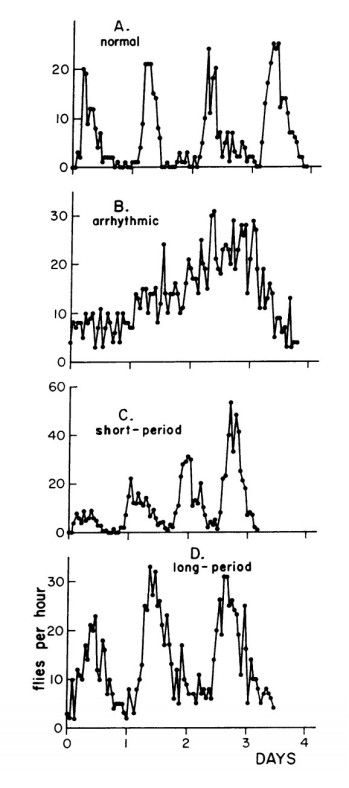2017 Nobel Prize in Physiology and Medicine was awarded to Jeffrey Hall, Michael Rosbash and Michael Young for the discovery of the molecular mechanism of circadian rhythm regulation.
So, what exactly is this about?
Have you ever travel to a different time zone and had difficulties following the local sleep time? Or have you walked in a park too later that you find the leaves hanging on their branches as though they were ‘resting’?
These are patterns observed by different people for centuries and yet its mechanism was not really studied until some scientists did some detailed experiment. The earlier study on circadian rhythm mechanism was done in fruit flies (Drosophila) by two scientists: Seymour Benzer and Ronald J. Konopka. They did random chemical mutations on fruit flies and studied on their eclosion cycle in constant darkness, which is the period of time for the flies to emerge from their pupae. They managed to isolate three mutants with different eclosion cycling rhythm compared to wild-type (24 hours): arrhythmic (random), shortened (19 hours) and lengthened (28 hours) cycle, as could be seen from the figure below.

Eclosion rhythms for normal and mutant flies studied by Benzer and Konopka.
They mapped out the affected mutation using markers and found these mutants to be mutated at a similar region. Few studies following this paper concluded it affected a gene that transcribed ‘period‘. Hall, Rosbash and Youngs’ work was significant in the sense that until then, there were not much known about this ‘period’ gene, at a molecular level.
What they found out next was amazing. Period gene which codes of PER mRNA and PER protein was abundant during the day in the cells and yet drops at night and cycles back to abundant again the next day. Several studies were done subsequently on PER and related protein to unravel the basic molecular mechanism that could illustrate the circadian rhythm as a whole.
PER was found to be a nuclear protein that could shuffle between nucleus and cytoplasm. At night, there was another protein, TIMELESS (TIM), that could bind with PER to protect it from being degraded. During the day, TIM will be degraded by binding to cryptochrome gene product (CRY) which was activated by light. This lead to PER vulnerable to another protein, DOUBLETIME (DBT), a kinase that could phosphorylate PER and lead to its degradation.
If you think that was it, you were very wrong. Turned out that TIM and PER gene expression was controlled by two gene products, CLOCK (CLK) and CYCLE (CYC). They sat on the enhancer box (E-Box) upstream of TIM and PER promoter and promotes the expression of their mRNA. And as though this wasn’t enough, TIM and PER themselves could negatively regulate CLK activity. This whole feedback loop was later known widely as the Transcription-Translation-Feedback-Loop (TTFL).
https://www.instagram.com/p/BZwIyrMnVam/
These studies on circadian rhythm are still going on since these groundbreaking discoveries. More and more regulation components and pathways were found and detailed since then. Not to forget, together with the advancement of technologies and new techniques that make these studies possible and easier to explore.
Nowadays, the target of this field was not only on its molecular mechanisms. Experts and enthusiasts around the world have been basing this discovery to understand human behaviour, health, ageing and well-being. There are yet many aspects to be explored and they would not have been possible without these pioneers who systematically and adventurously ventured into this pathway.
Reference:
Allada, R., White, N. E., So, W. V., Hall, J. C., & Rosbash, M. (1998). A mutant Drosophila homolog of mammalian clock disrupts circadian rhythms and transcription of period and timeless. Cell, 93(5), 791–804. https://doi.org/10.1016/S0092-8674(00)81440-3
Emery, P., So, W. V., Kaneko, M., Hall, J. C., & Rosbash, M. (1998). CRY, a Drosophila Clock and Light-Regulated Cryptochrome, Is a Major Contributor to Circadian Rhythm Resetting and Photosensitivity. Cell, 95(5), 669–679. https://doi.org/10.1016/S0092-8674(00)81637-2
Hardin, P. E., Hall, J. C., & Rosbash, M. (1990). Feedback of the Drosophila period gene product on circadian cycling of its messenger RNA levels. Nature, 343(6258), 536–540. https://doi.org/10.1038/343536a0
Kivimäe, S., Saez, L., & Young, M. W. (2008). Activating PER repressor through a DBT-directed phosphorylation switch. PLoS Biology, 6(7), 1570–1583. https://doi.org/10.1371/journal.pbio.0060183
Konopka, R. J., & Benzer, S. (1971). Clock mutants of Drosophila melanogaster. Proceedings of the National Academy of Sciences of the United States of America, 68(9), 2112–6. https://doi.org/10.1073/pnas.68.9.2112
